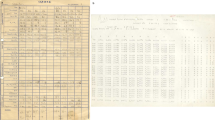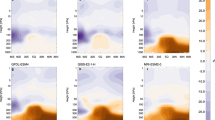Abstract
Anthropogenic ozone radiative forcing is traditionally separately attributed to tropospheric and stratospheric changes assuming that these have distinct causes1. Using the interactive composition–climate model GISS-E2-R we find that this assumption is not justified. Our simulations show that changes in emissions of tropospheric ozone precursors have substantial effects on ozone in both regions, as do anthropogenic halocarbon emissions. On the basis of our results, further simulations with the NCAR-CAM3.5 model2, and published studies3,4, we estimate industrial era (1850–2005) whole-atmosphere ozone forcing of ∼0.5 W m−2 due to anthropogenic tropospheric precursors and about −0.2 W m−2 due to halocarbons. The net troposphere plus stratosphere forcing is similar to the net halocarbon plus precursor ozone forcing, but the latter provides a more useful perspective. The halocarbon-induced ozone forcing is roughly two-thirds the magnitude of the halocarbon direct forcing but opposite in sign, yielding a net forcing of only ∼0.1 W m−2. Thus, the net effect of halocarbons has been smaller, and the effect of tropospheric ozone precursors has been greater, than generally recognized.
This is a preview of subscription content, access via your institution
Access options
Subscribe to this journal
Receive 12 print issues and online access
$209.00 per year
only $17.42 per issue
Buy this article
- Purchase on Springer Link
- Instant access to full article PDF
Prices may be subject to local taxes which are calculated during checkout



Similar content being viewed by others
References
Forster, P. et al. in IPCC Climate Change 2007: The Physical Science Basis (eds Solomon, S. et al.) 129–234 (Cambridge Univ. Press, 2007).
Lamarque, J. et al. CAM-chem: Description and evaluation of interactive atmospheric chemistry in the community Earth system model. Geosci. Model Dev. 5, 369–411 (2012).
Sovde, O., Hoyle, C., Myhre, G. & Isaksen, I. The HNO3 forming branch of the HO2+NO reaction: Pre-industrial-to-present trends in atmospheric species and radiative forcings. Atmos. Chem. Phys. 11, 8929–8943 (2011).
Gauss, M. et al. Radiative forcing since preindustrial times due to ozone change in the troposphere and the lower stratosphere. Atmos. Chem. Phys. 6, 575–599 (2006).
Cionni, I. et al. Ozone database in support of CMIP5 simulations: Results and corresponding radiative forcing. Atmos. Chem. Phys. 11, 11267–11292 (2011).
Lamarque, J-F. et al. Historical (1850–2000) gridded anthropogenic and biomass burning emissions of reactive gases and aerosols: Methodology and application. Atmos. Chem. Phys. 10, 7017–7039 (2010).
Austin, J. et al. Chemistry-climate model simulations of spring Antarctic ozone. J. Geophys. Res. 115, D00M11 (2010).
Ramaswamy, V. et al. in IPCC Climate Change 2001: The Scientific Basis (ed. Houghton, T.) 349–416 (Cambridge Univ. Press, 2001).
Lacis, A., Wuebbles, D. J. & Logan, J. A. Radiative forcing of climate by changes in the vertical distribution of ozone. J. Geophys. Res. 95, 9971–9981 (1990).
Osterman, G. B. et al. Validation of tropospheric emission spectrometer (TES) measurements of the total, stratospheric, and tropospheric column abundance of ozone. J. Geophys. Res. 113, D15S16 (2008).
Newman, P. et al. What would have happened to the ozone layer if chlorofluorocarbons (CFCs) had not been regulated? Atmos. Chem. Phys. 9, 2113–2128 (2009).
Velders, G., Andersen, S., Daniel, J., Fahey, D. & McFarland, M. The importance of the Montreal Protocol in protecting climate. Proc. Natl Acad. Sci. USA 104, 4814–4819 (2007).
Nassar, R. et al. Validation of tropospheric emission spectrometer (TES) nadir ozone profiles using ozonesonde measurements. J. Geophys. Res. 113, D15S17 (2008).
Dee, D. et al. The ERA-Interim reanalysis: Configuration and performance of the data assimilation system. Q. J. R. Meteorol. Soc. 137, 553–597 (2011).
Shindell, D. T. et al. Interactive ozone and methane chemistry in GISS-E2 historical and future climate simulations. Atmos. Chem. Phys. (in the press).
Oltmans, S. et al. Long-term changes in tropospheric ozone. Atmos. Environ. 40, 3156–3173 (2006).
Parrish, D. D., Millet, D. B. & Goldstein, A. H. Increasing ozone in marine boundary layer inflow at the west coasts of North America and Europe. Atmos. Chem. Phys. 9, 1303–1323 (2009).
McPeters, R. et al. Validation of the aura ozone monitoring instrument total column ozone product. J. Geophys. Res. 113, D15S14 (2008).
Randel, W. & Wu, F. A stratospheric ozone profile data set for 1979–2005: Variability, trends, and comparisons with column ozone data. J. Geophys. Res. 111, D06313 (2007).
Worden, H., Bowman, K., Kulawik, S. & Aghedo, A. Sensitivity of outgoing longwave radiative flux to the global vertical distribution of ozone characterized by instantaneous radiative kernels from Aura-TES. J. Geophys. Res. 116, D14115 (2011).
Acknowledgements
We thank NASA MAP for financial support and the NCCS for computer services.
Author information
Authors and Affiliations
Contributions
G.F. performed the GISS composition simulations, L.N. and R.R. performed the GISS RTM calculations, K.B. facilitated use of the TES data, J-F.L. performed the NCAR simulations, A.V., G.A.S., O.P. and D.S. contributed to developing and evaluation the GISS composition model, D.S. conceived and led the study, and all authors contributed to writing the paper.
Corresponding author
Ethics declarations
Competing interests
The authors declare no competing financial interests.
Rights and permissions
About this article
Cite this article
Shindell, D., Faluvegi, G., Nazarenko, L. et al. Attribution of historical ozone forcing to anthropogenic emissions. Nature Clim Change 3, 567–570 (2013). https://doi.org/10.1038/nclimate1835
Received:
Accepted:
Published:
Issue Date:
DOI: https://doi.org/10.1038/nclimate1835
This article is cited by
-
Stratospheric ozone, UV radiation, and climate interactions
Photochemical & Photobiological Sciences (2023)
-
Externally forced symmetric warming in the Arctic and Antarctic during the second half of the twentieth century
Geoscience Letters (2022)
-
Environmental effects of stratospheric ozone depletion, UV radiation, and interactions with climate change: UNEP Environmental Effects Assessment Panel, Update 2020
Photochemical & Photobiological Sciences (2021)
-
Historical total ozone radiative forcing derived from CMIP6 simulations
npj Climate and Atmospheric Science (2020)
-
Interannual and Decadal Changes in Tropospheric Ozone in China and the Associated Chemistry-Climate Interactions: A Review
Advances in Atmospheric Sciences (2019)



